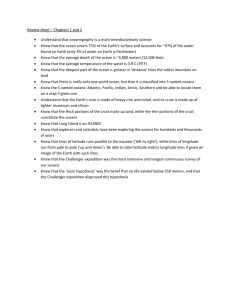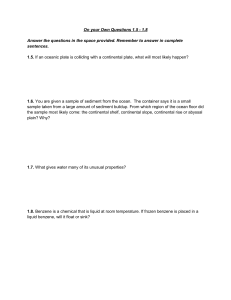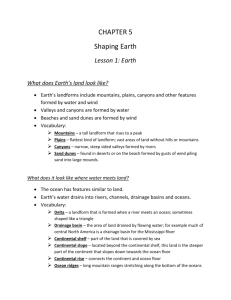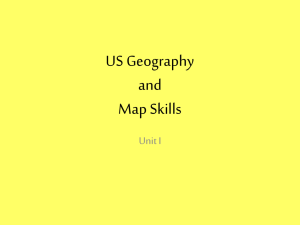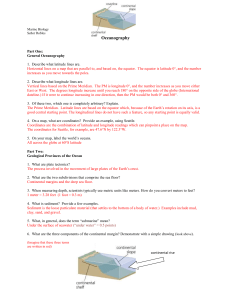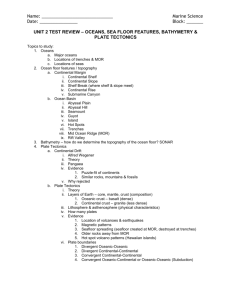Study guide
advertisement
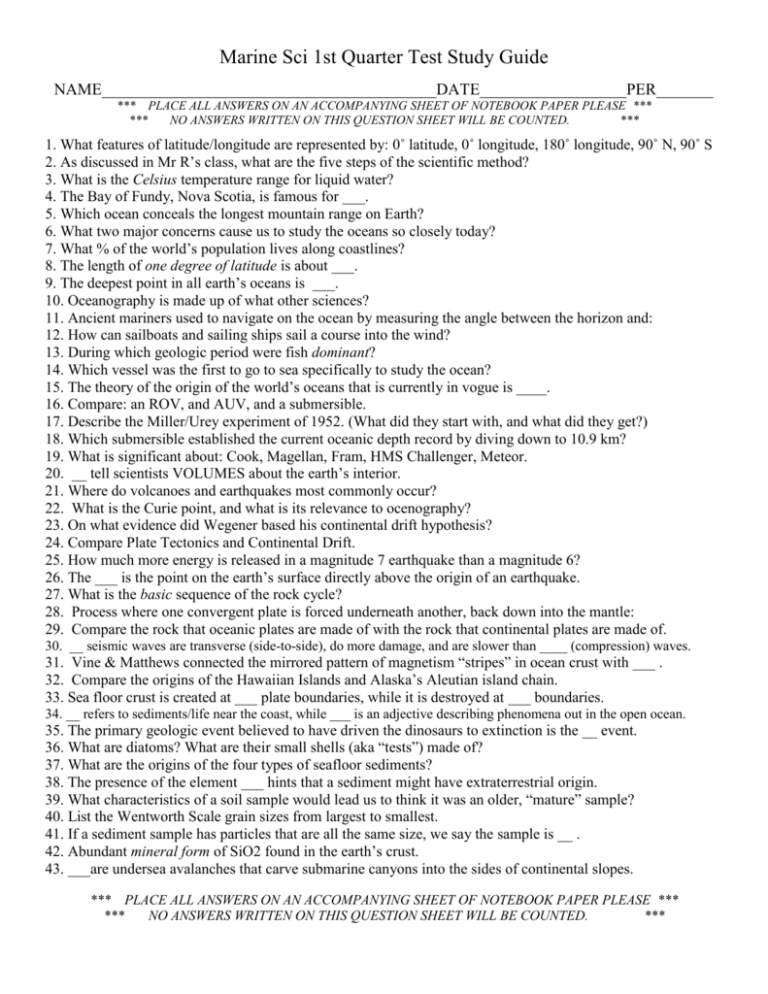
Marine Sci 1st Quarter Test Study Guide NAME_________________________________________DATE__________________PER_______ *** PLACE ALL ANSWERS ON AN ACCOMPANYING SHEET OF NOTEBOOK PAPER PLEASE *** *** NO ANSWERS WRITTEN ON THIS QUESTION SHEET WILL BE COUNTED. *** 1. What features of latitude/longitude are represented by: 0˚ latitude, 0˚ longitude, 180˚ longitude, 90˚ N, 90˚ S 2. As discussed in Mr R’s class, what are the five steps of the scientific method? 3. What is the Celsius temperature range for liquid water? 4. The Bay of Fundy, Nova Scotia, is famous for ___. 5. Which ocean conceals the longest mountain range on Earth? 6. What two major concerns cause us to study the oceans so closely today? 7. What % of the world’s population lives along coastlines? 8. The length of one degree of latitude is about ___. 9. The deepest point in all earth’s oceans is ___. 10. Oceanography is made up of what other sciences? 11. Ancient mariners used to navigate on the ocean by measuring the angle between the horizon and: 12. How can sailboats and sailing ships sail a course into the wind? 13. During which geologic period were fish dominant? 14. Which vessel was the first to go to sea specifically to study the ocean? 15. The theory of the origin of the world’s oceans that is currently in vogue is ____. 16. Compare: an ROV, and AUV, and a submersible. 17. Describe the Miller/Urey experiment of 1952. (What did they start with, and what did they get?) 18. Which submersible established the current oceanic depth record by diving down to 10.9 km? 19. What is significant about: Cook, Magellan, Fram, HMS Challenger, Meteor. 20. __ tell scientists VOLUMES about the earth’s interior. 21. Where do volcanoes and earthquakes most commonly occur? 22. What is the Curie point, and what is its relevance to ocenography? 23. On what evidence did Wegener based his continental drift hypothesis? 24. Compare Plate Tectonics and Continental Drift. 25. How much more energy is released in a magnitude 7 earthquake than a magnitude 6? 26. The ___ is the point on the earth’s surface directly above the origin of an earthquake. 27. What is the basic sequence of the rock cycle? 28. Process where one convergent plate is forced underneath another, back down into the mantle: 29. Compare the rock that oceanic plates are made of with the rock that continental plates are made of. 30. __ seismic waves are transverse (side-to-side), do more damage, and are slower than ____ (compression) waves. 31. Vine & Matthews connected the mirrored pattern of magnetism “stripes” in ocean crust with ___ . 32. Compare the origins of the Hawaiian Islands and Alaska’s Aleutian island chain. 33. Sea floor crust is created at ___ plate boundaries, while it is destroyed at ___ boundaries. 34. __ refers to sediments/life near the coast, while ___ is an adjective describing phenomena out in the open ocean. 35. The primary geologic event believed to have driven the dinosaurs to extinction is the __ event. 36. What are diatoms? What are their small shells (aka “tests”) made of? 37. What are the origins of the four types of seafloor sediments? 38. The presence of the element ___ hints that a sediment might have extraterrestrial origin. 39. What characteristics of a soil sample would lead us to think it was an older, “mature” sample? 40. List the Wentworth Scale grain sizes from largest to smallest. 41. If a sediment sample has particles that are all the same size, we say the sample is __ . 42. Abundant mineral form of SiO2 found in the earth’s crust. 43. ___are undersea avalanches that carve submarine canyons into the sides of continental slopes. *** PLACE ALL ANSWERS ON AN ACCOMPANYING SHEET OF NOTEBOOK PAPER PLEASE *** *** NO ANSWERS WRITTEN ON THIS QUESTION SHEET WILL BE COUNTED. ***
